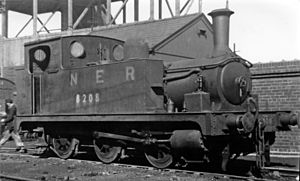| GCR Class 5A LNER Class J63 | |||||||||||||||||||||||||||||||||||||
|---|---|---|---|---|---|---|---|---|---|---|---|---|---|---|---|---|---|---|---|---|---|---|---|---|---|---|---|---|---|---|---|---|---|---|---|---|---|
 No. 8208 at Immingham engine shed in 1947 | |||||||||||||||||||||||||||||||||||||
| |||||||||||||||||||||||||||||||||||||
| |||||||||||||||||||||||||||||||||||||
| |||||||||||||||||||||||||||||||||||||
| |||||||||||||||||||||||||||||||||||||
The GCR Class 5A was a class of seven 0-6-0T steams designed by John G. Robinson for work in docks operated by the Great Central Railway.[1] They passed to the London and North Eastern Railway at the grouping in 1923 and received the LNER classification J63.
History
[edit]The class was introduced in 1906 as a replacement for the GCR Class 4 dock shunters, based on his predecessor's GCR Class 5 but with side tanks rather than saddle tanks. A seventh locomotive was built in 1914.
All seven examples survived into British Railways ownership in 1948, at least one being at Immingham in 1952,[2] and at least one at Connah's Quay in 1954.[3] They were all withdrawn between 1953 and 1957.
References
[edit]- ^ Goode 1985, p. 54.
- ^ Ludlam 2016, p. 15.
- ^ Green 1996, p. 34.
Sources
[edit]- Allen, D. W.; Boddy, M. G.; Brown, W. A.; Fry, E. V.; Hennigan, W.; Manners, F.; Neve, E.; Proud, P.; Roundthwaite, T. E.; Tee, D. F.; Yeadon, W. B. (November 1970), Fry, E. V. (ed.), Locomotives of the L.N.E.R., part 8A: Tank Engines - Classes J50 to J70, Kenilworth: RCTS, ISBN 0-901115-05-3[page needed]
- Goode, C. Tony (1985). Railways of North Lincolnshire. Anlaby, Hull: C.T.Goode. ISBN 0-9508239-7-X.
- Green, C.C. (1996) [1983]. North Wales Branch Line Album. Shepperton: Ian Allan Publishing. ISBN 0-7110-1252-0.
- Hancox, A.C. (1995), The Harmonious Blacksmith Robinson, The Stephenson Locomotive Society, ISBN 0-903881-03-9[page needed]
- Ludlam, A.J. (2016). Immingham - A Lincolnshire Railway Centre (Lincolnshire Railway Centres). Ludborough, Lincolnshire: Lincolnshire Wolds Railway Society. ISBN 978-0995461000.
External links
[edit]- The Robinson J63 (GCR Class 5) 0-6-0ST Locomotives; LNER Encyclopedia
- Images of J63s, with random others, via Yahoo
Well, that’s interesting to know that Psilotum nudum are known as whisk ferns. Psilotum nudum is the commoner species of the two. While the P. flaccidum is a rare species and is found in the tropical islands. Both the species are usually epiphytic in habit and grow upon tree ferns. These species may also be terrestrial and grow in humus or in the crevices of the rocks.
View the detailed Guide of Psilotum nudum: Detailed Study Of Psilotum Nudum (Whisk Fern), Classification, Anatomy, Reproduction